ATTENTION! Due To Extremely High Demand, ThermPix® Thermovisual Device Inventory May Be Limited. Act Now To Ensure Availability!
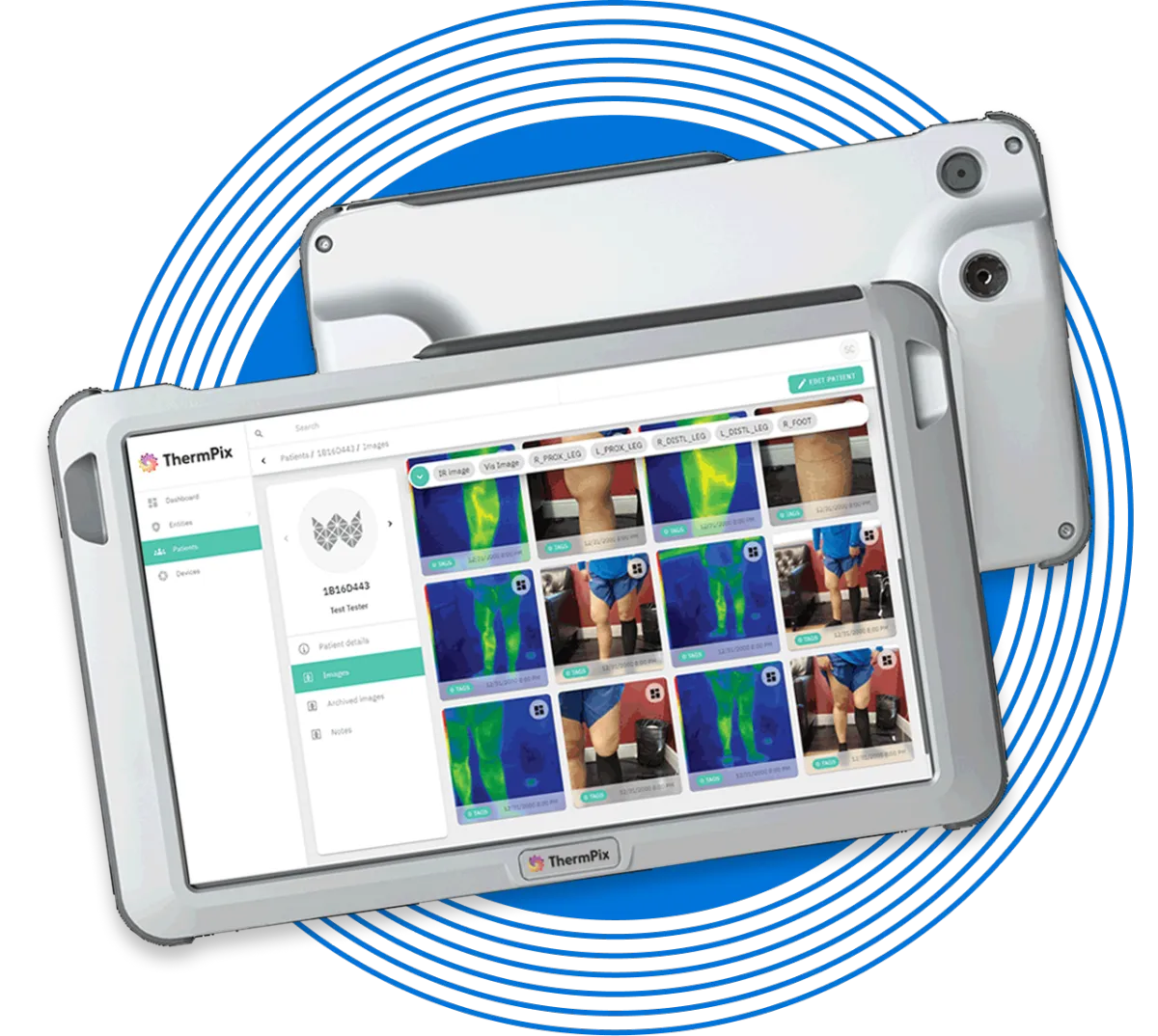
ThermPix® Infrared Camera Transforms Vascular Screening!
Detect Venous Disorders Faster, Safer & More Accurately, Even Before Ultrasound Does!
Clinician-Trusted Technology to Help You:
Identify Early-Stage Chronic Venous Insufficiency
Visualize Heat Patterns That Reveal Refluxing Veins
Improve Mapping Accuracy & Diagnostic Efficiency
Enhance Patient Trust With Instant, Visual Proof

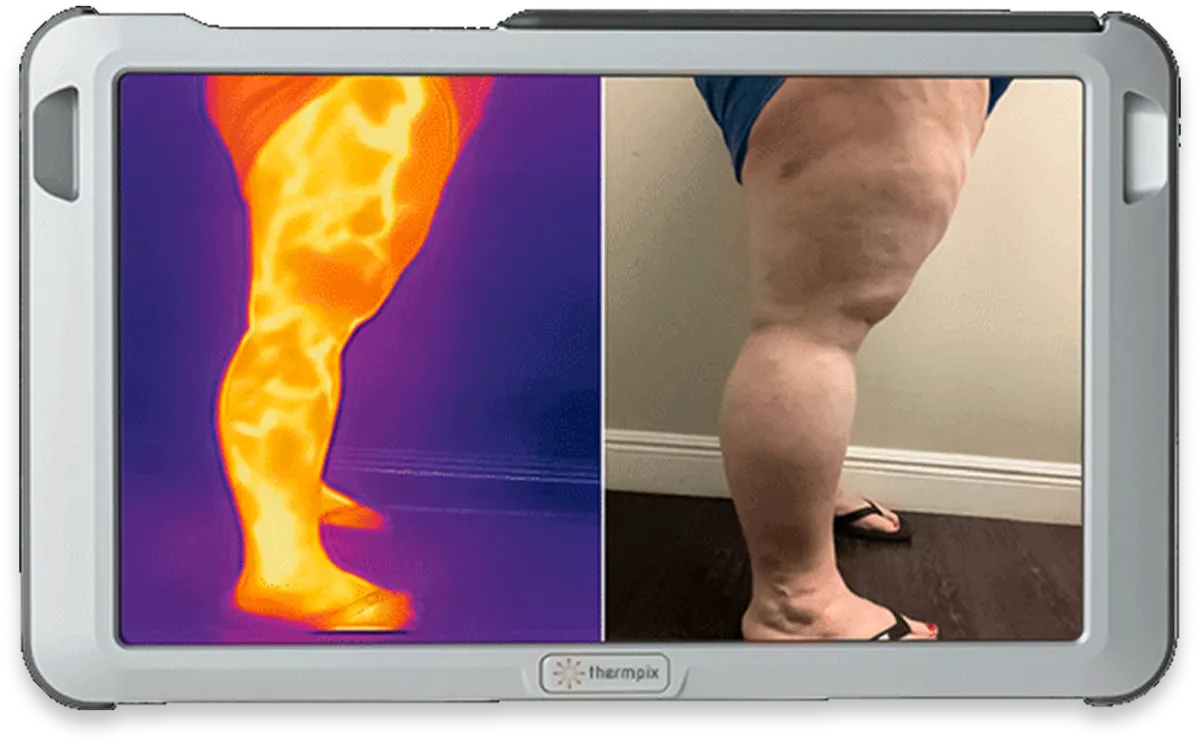
Frustrated when duplex scans miss clear symptoms? Patients keep coming back, but you still can't find reflux on imaging?
You’re not the only one. Many providers face this daily, especially with patients who can’t stand long, have larger limbs, or show no reflux during the scan.
ThermPix® helps fill the gap by giving you a fast, visual snapshot of abnormal heat patterns linked to venous issues. It helps you target the right vessels faster, avoid wasted scan time, and improve accuracy. When patients see the thermal scan, they instantly understand and trust your next step.
Did You Know…
...Early venous disease often gets missed on ultrasound, especially in complex cases.
ThermPix® Helps You Spot What Other Tools Miss:

Missed reflux in hard-to-scan patients

Inconclusive or delayed ultrasound results

Poor patient understanding and case acceptance
How ThermPix® Enhances Vascular Screening and Diagnostic Precision
In just four simple steps, ThermPix® helps your clinic capture, assess, and share thermal data that improves how you diagnose and treat patients.
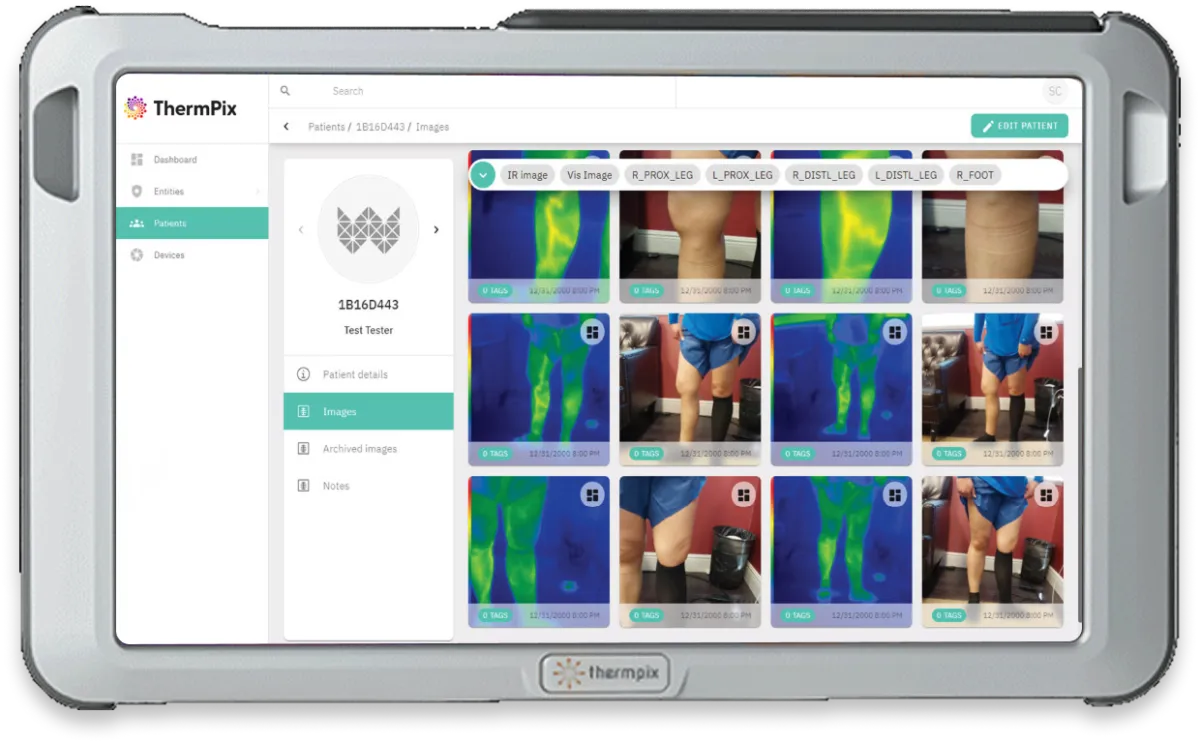

Connect to WiFi
Power on and connect ThermPix® to your clinic’s secure network.

Capture Thermal Patterns
Scan and assess heat signatures in real time to detect potential venous abnormalities.

Upload Securely to the Cloud
Automatically sync images to a HIPAA-compliant cloud for safe storage and easy access.

Share and Collaborate
Easily review with patients or share with care teams to support treatment decisions.
ThermPix® Captures
What is Invisible
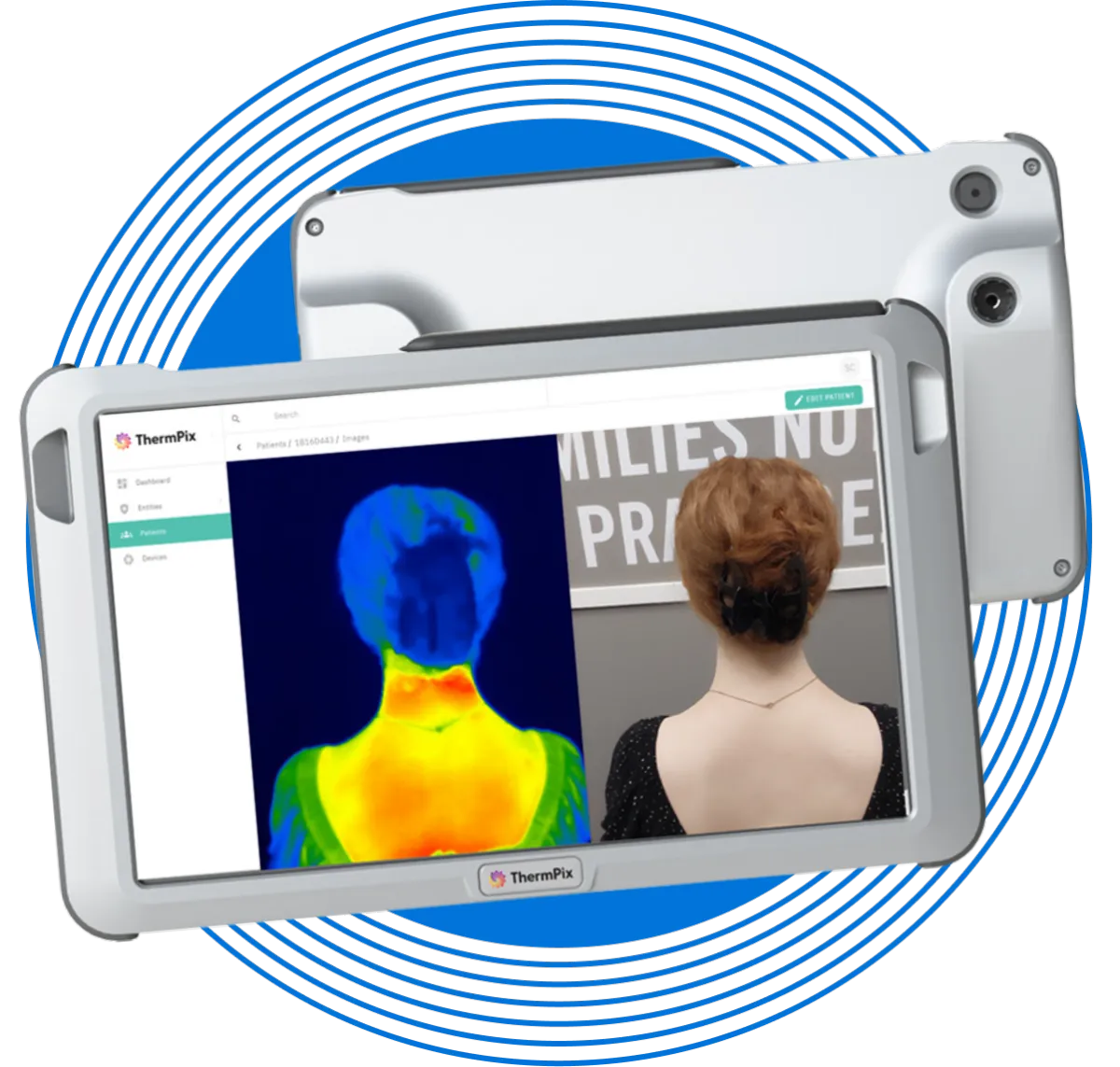

Precise Visualization
ThermPix® provides accurate images of heat patterns and variations within the body.

Non-Invasive
ThermPix® thermovisual imaging is contact-free, with no radiation and takes only a few seconds.

Portable
The point of care thermography can be used in any health setting and images can be accessed on multiple devices.

EMR Integration
Recorded images can be accessed on mobile devices, tablets, laptops, desktops, and workstations.
Testimonials
ThermPix®’s Impact:
Real Clinics. Real Results.
This Works...

We used to struggle with patients who showed symptoms but had clean duplex scans. Since adding ThermPix®, we’ve been able to identify early-stage reflux faster and with more confidence. It’s now part of every new patient screening.

Dr. Amanda R.

Verified Buyer
This Works...

ThermPix® helped us detect thermal changes in patients with thickened skin and larger body size where DUS often misses. It gives us a visual starting point, and patients actually understand what’s going on. Game-changer.

Dr. Lee M.

Verified Buyer
Our Team Loves It

It’s so easy to use and fits right into our existing process. Capturing and uploading thermal scans takes less than a minute. Our sonographers now use it to guide their ultrasound and patient trust has gone way up.

Sarah T., RVT

Verified Buyer
Why ThermPix® Stands Out
See how ThermPix® compares to traditional tools in vascular imaging.
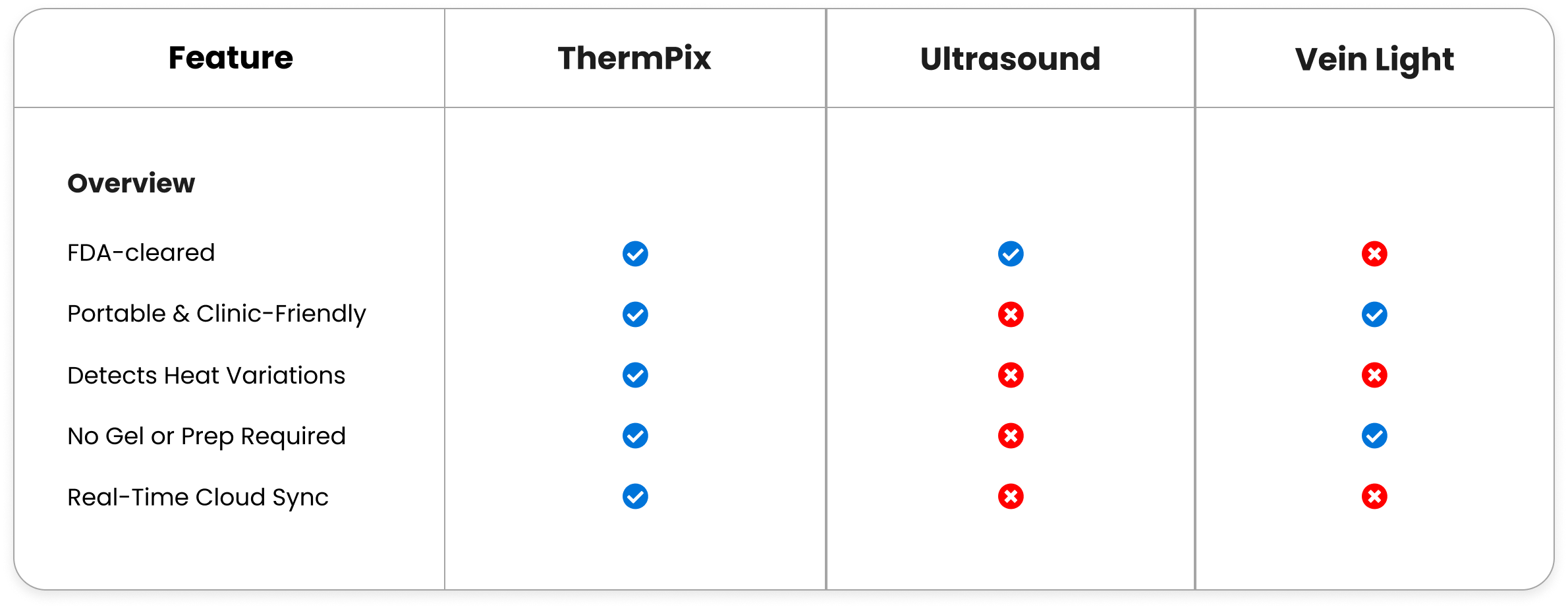
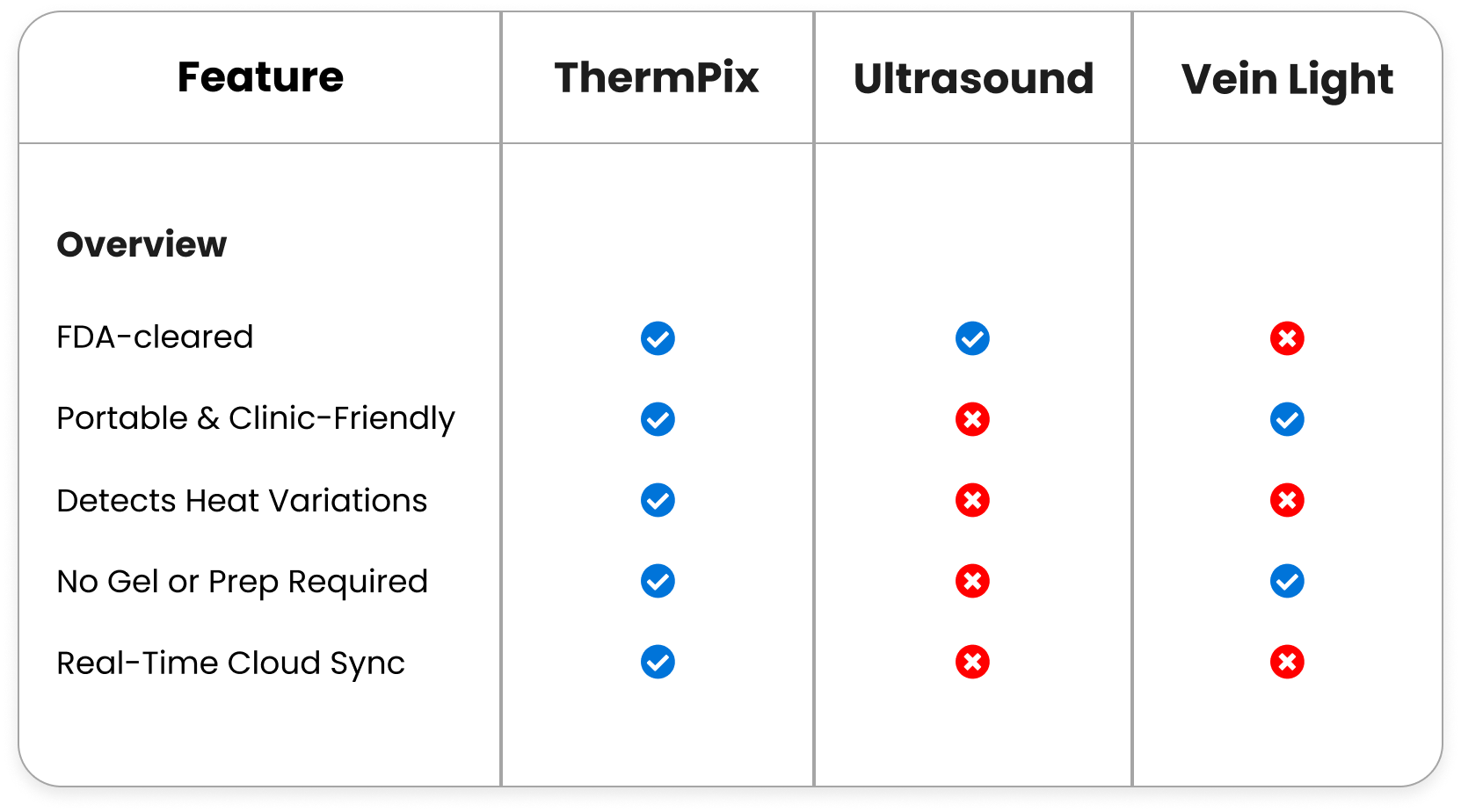
Simple Plans. Powerful Tools. Built for Clinics of Any Size.
Choose the bundle that fits your workflow. Every plan includes the ThermPix® device, a 12-month cloud subscription, and training videos.
Single
(1 Unit)
Best for solo or single-location clinics
1 ThermPix® - FDA Cleared Broad Indication Medical Device
12-month cloud subscription
Embedded Training Videos
Protective Carrying Case
Tablet Stand
Second Year Subscription Plan: $300/month
Today just:
$7,800
$6,594/unit
Clinic
(2–4 Units)
Ideal for group practices and shared clinics
1 ThermPix® - FDA Cleared Broad Indication Medical Device
12-month cloud subscription
Embedded Training Videos
Protective Carrying Case
Tablet Stand
Second Year Subscription Plan: $300/month
$7,600
$6,265/unit
Group
(5-9 Units)
Best for growing or mid-sized operators
1 ThermPix® - FDA Cleared Broad Indication Medical Device
12-month cloud subscription
Embedded Training Videos
Protective Carrying Case
Tablet Stand
Second Year Subscription Plan: $300/month
Today just:
$7,400
$5,635/unit
Enterprise
(10+ Units)
For large groups, mobile teams, and multi-locations
1 ThermPix® - FDA Cleared Broad Indication Medical Device
12-month cloud subscription
Embedded Training Videos
Protective Carrying Case
Tablet Stand
Second Year Subscription Plan: $300/month
Today just:
$7,200
$5,310/unit
What’s Included in Every Subscription Bundle

What’s Included in Every Subscription Bundle
1 Hour of hands on Live Training with our ThermLab Specialists
Embedded ThermPix Training Videos
Unlimited ThermGuard Warranty active subscription (excludes misuse, neglect, accident, or improper use according to USATherm instructions)
Unlimited over the over-air software upgrades
Unlimited Cloud Based Thermographic Imaging Cataloguing and Categorizing (PACS)
Unlimited Cloud-Based Clinical Photographic Imaging Cataloguing and Categorizing (PACS)
30-Day Unconditional Trial Period. (Minus a $350 restore & restock fee)
Unlimited ability to use Basic ThermPix App Store Ecosystem
Online Meeting App (B2B) Included
Unlimited ability to use specific AI features* with appropriate ThermPix Software Plan.
ThermPix Imaging Station for registered PACS systems like SARC-MediQ (others coming soon)
Upcoming EMR integration capacity with ECW, Epic (and others) additional costs may apply
White glove technical support available (ask for pricing)
Frequently Asked Questions
What is the ThermPix device used for?
The ThermPix device is a thermal imaging tool designed primarily for detecting and assessing chronic venous insufficiency (CVI) in the legs. It provides non-invasive imaging that helps visualize heat patterns associated with blood flow abnormalities, enhancing diagnostic capabilities when used with ultrasound.
How does ThermPix differ from traditional ultrasound?
ThermPix complements traditional Doppler ultrasound by providing additional data through thermal imaging, which detects temperature variations that may indicate blood flow irregularities. While Doppler ultrasound is the gold standard for locating sites of venous insufficiency, ThermPix can reduce procedural time and may help identify affected areas faster.
Is ThermPix safe to use?
Yes, ThermPix is completely non-invasive and uses infrared thermal imaging, which does not involve any radiation or direct contact with the skin, making it safe for repeated use.
How accurate is the ThermPix device in detecting venous insufficiency?
ThermPix has shown promising results in improving detection rates when used alongside Doppler ultrasound. In control studies, it has been found to enhance accuracy by identifying additional sites of venous insufficiency that may not be as easily detected by ultrasound alone.
What are the benefits of using ThermPix for clinicians?
ThermPix provides a quick, non-invasive assessment that can reduce procedural time and improve diagnostic accuracy. By combining thermal imaging with ultrasound, it allows clinicians to better visualize and assess areas affected by venous insufficiency.
Who is the ideal candidate for a ThermPix scan?
ThermPix is suitable for patients showing signs or symptoms of venous insufficiency in the legs. It can also be useful for follow-up assessments in patients with a history of CVI, as it aids in tracking changes in blood flow over time.
Does ThermPix require special training to operate?
While the ThermPix device is user-friendly, some initial training is recommended for clinicians to ensure accurate interpretation of thermal imaging data. This training can be completed quickly and enables clinicians to maximize the device's diagnostic capabilities.
Can ThermPix be used in mobile or outpatient settings?
Yes, ThermPix is designed to be portable and easy to use, making it ideal for outpatient clinics, mobile health units, and even home visits if needed.
How does ThermPix improve patient outcomes?
By enhancing diagnostic accuracy and reducing the time required for assessments, ThermPix helps in earlier and more precise identification of venous insufficiency, leading to better-informed treatment plans and potentially improved patient outcomes.
Is ThermPix compatible with existing ultrasound systems?
Yes, ThermPix is compatible with most Doppler ultrasound systems. It is intended to be used alongside ultrasound imaging as a complementary tool.
What are the maintenance requirements for ThermPix?
ThermPix requires minimal maintenance. Regular calibration and software updates ensure optimal performance. Detailed guidelines for maintenance are provided to all purchasers.
Does insurance cover ThermPix scans?
Coverage may vary depending on the insurer and the specific clinical use of the ThermPix device. It’s recommended to consult with individual insurance providers regarding coverage policies for thermal imaging in the context of venous insufficiency diagnostics.
What is the sensitivity of the scan for size and duration of reflex?
Our previously published data showed a sensitivity and specificity that was greater than 95% for clinically significant venous reflux. Ongoing studies are underway to reproduce those initial peer reviewed publications and we believe it will further validate initial studies.
Thermal imaging signal of venous insufficiency is created by heat transfer from (hot, core temperature blood) refluxing and warming the skin over the vein directly beneath the skin. Deeper veins such as the GSV in the upper thigh are not seen as they are beneath the insulating subcutaneous tissue and adjacent to other deep structure also at core temperature. The thermal gradient approximately 7 degrees c is more than sufficient so even a relatively small amount of reflux becomes apparent. The fact that it has it’s origin typically at the SFJ means the reflux is continuous until the highest superficial vein and therefore is clinically relevant.
Will the scan detect veins with greater than 0.5 sec of reflux?
Our current parameters for our AI detection mechanism uses 0.5 sec of reflux as its baseline. We expect a commercially available version of this AI tool (that correlates to the gold standard of Duplex Ultransography reflux of 0.5 sec of reflux to be released next quarter, 2025.
The original description of reflux duration of 0.5s is based on a false premise that the valves are slow to close (Van Bemmelen, Arch Surg 1990) allowing reflux. As in the response to your first question the reflux is transmitted down the leg, longer reflux being less physiologically important. Short reflux 1-3 s is more significant. Short duration high flow reflux will deliver ample heat energy and be obvious on thermal imaging. As the 0.5 s reflux has been adopted as the criterion for pathological reflux we have used this in our studies and both sensitivity and specificity are very high, as more evidence emerges we believe positive thermal images will provide better evidence of clinically (physiological) important reflux than a somewhat arbitrary reflux time which can be manipulated. Very long reflux (20s+), with slow flow and small diameter veins may not be clearly detectable on thermal, but similarly is unlikely to be physiologically important. In clinical practise this has not been an issue.
What sized veins will show up as red/abnormal? Is this adjustable?
Almost any vein that is refluxing (and dilated) and near enough to the surface will show an abnormal temperature gradient. Non refluxing veins will not show up (at all) abnormal as the (there is no) heat gradient will be (between the vein and) skin temperature, not elevated from the deeper core reflux and thus thermographically silent. We can adjust ThermPix individually but the baseline settings are usually considered by most to be ideal for CVI.
The thermal camera is already very sensitive, 0.1 c, if the temperature range is narrowed the thermal picture may look dramatic but does not in reality have any additional information or improve the sensitivity or specificity of the technique. Typically, the temperature difference between the skin over an incompetent superficial vein and adjacent skin is 2-3 c. The stored data contains all the point temperature information, approximately 150,000 data points.
Copyright © Thermpix. All rights reserved.
Designed by Kuan Kei Choong